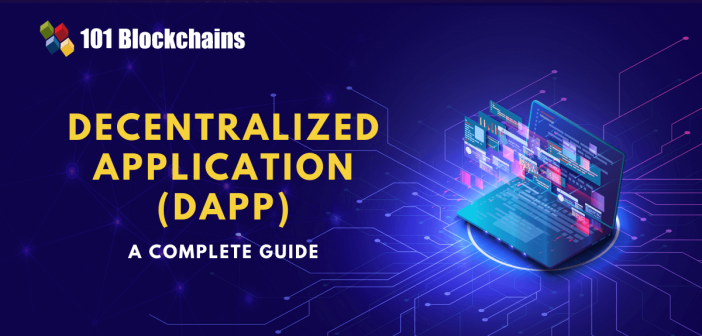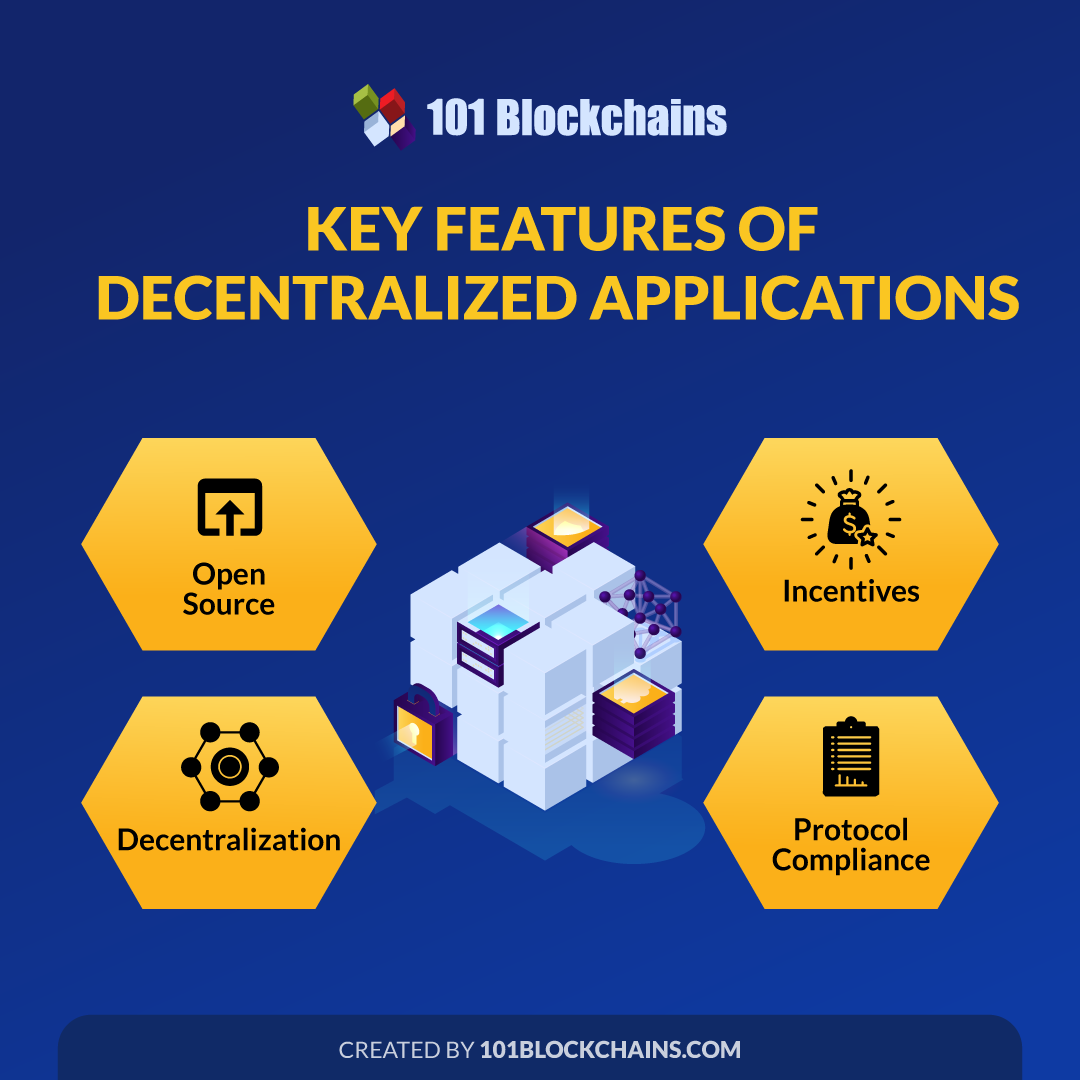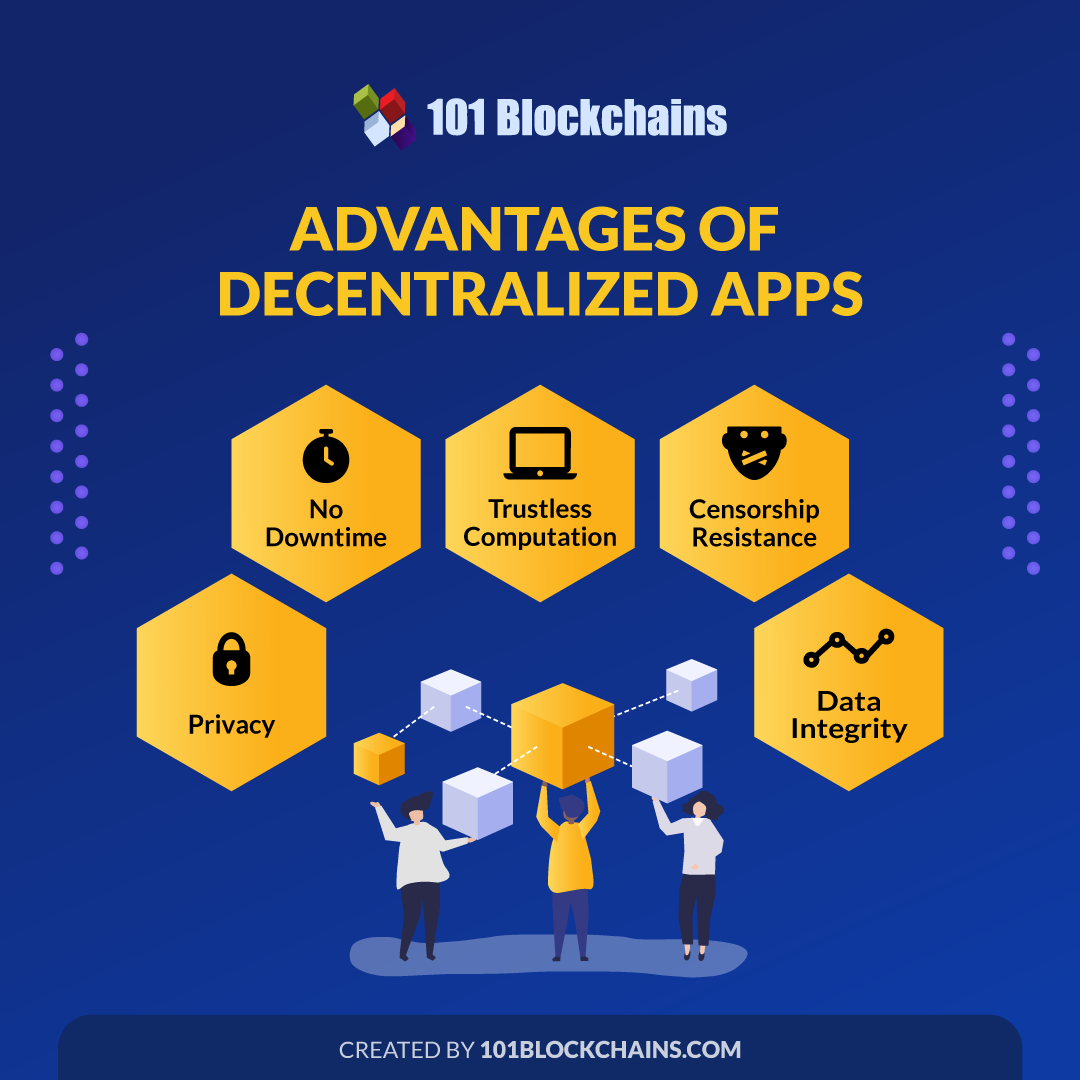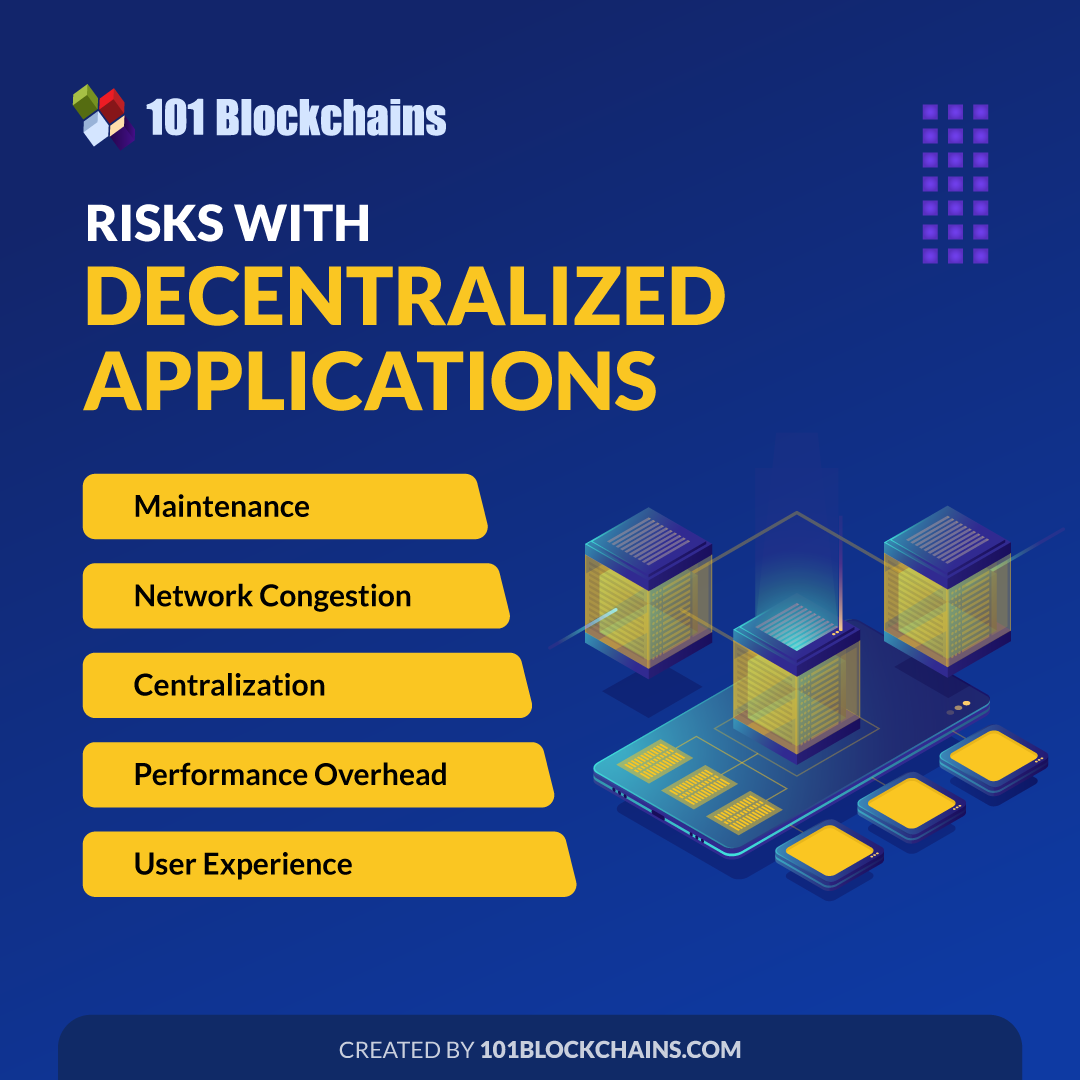Learn how blockchain truly works, master key definitions, and uncover what makes smart contracts so "smart." Dive into the fundamentals, gain valuable insights, and start your blockchain journey today!

- Guides
Hasib Anwar
- on December 10, 2021
Beginner’s Guide: What is a Decentralized Application (DApp)?
Do you know Decentralized Applications (dApps) play a crucial role in bringing the applications of blockchain into action? Let’s dive in to learn the concepts of dApp (decentralized application)!
Bitcoin and blockchain have a huge role in changing the way we visualize and use technology to our advantage. Over the course of time, blockchain technology has turned into a promising foundation for enterprise applications across different industries. Industries are using blockchain for tracking supply chain and logistics management, while some countries have adopted blockchain for identity mechanisms.
Wasn’t blockchain meant to develop cryptocurrencies only? No, blockchain has many more functionalities, and decentralized application helps in expanding the uses of blockchain. With the global blockchain market slated to achieve the $69 billion mark by 2027, it is quite reasonable to think about decentralized apps or dApps. The following discussion helps you understand what a dApp is alongside an in-depth overview of how it works. You can also discover the pros and cons of dApps alongside examples of popular decentralized apps in the following discussion.
Build your identity as a certified blockchain expert with 101 Blockchains’ Blockchain Certifications designed to provide enhanced career prospects.
What is dApp?
The arrival of Bitcoin almost a decade ago spurred a new age in the development of blockchain protocols. Developers have been trying to refine and add some exciting new functionalities in blockchain protocols tailored for various use cases. Today, you can find a wide range of applications of blockchain in finance, gaming, web browsing, and even for collecting art.
How is it possible to implement blockchain in so many different use cases? The answer would directly lead you to the dApp blockchain relationship. Decentralized applications or dApps are basically similar to traditional software programs, which run on blockchain networks rather than central servers. If you look for a technical answer for “what is dApp”, then it is basically an application developed over a decentralized network. The dApps are never under the management or ownership of a third-party authority, thereby ensuring decentralization.
Before diving deeper into the components and working of a decentralized application, let us reflect on the popularity of dApps. As compared to the 25 dApps in 2015, we have more than 3600 dApps spanning different areas such as games, decentralized finance services, social media platforms, and many more. Furthermore, decentralized apps are responsible for almost $182.5 billion worth of user transactions annually. Therefore, one could clearly note that dApp is a significant topic in the world of blockchain.
Want to learn about the fundamentals of dAPP development? Checkout Beginner’s Guide To DApp Development
Working of dApps
As we are discussing the dApp blockchain connection, it is important to dig deeper into the design of dApps. Decentralized applications include a frontend and a backend as the two important components in their design. The frontend helps in communicating with the user, while the backend code is basically a smart contract. Now, the smart contract is where blockchain jumps in the answers for ‘what is dApp’ and most prominently refers to the Ethereum blockchain.
The front end of the decentralized application is actually the code executed on the user side of an application. It basically serves as the interface for communication between the user and the application. In addition, the frontend of dApps also includes a digital wallet that serves different functions.
The digital wallet maintains a record of private and public keys of users for authentication purposes. In addition, the digital wallet helps in interacting with blockchain for management of blockchain addresses and cryptographic keys. The digital wallet in the dApp frontend also helps in triggering the execution of backend or smart contracts.
The backend of decentralized applications brings an interesting twist with the use of smart contracts running on the server-side of the application. You have the backend of dApps on a blockchain where it is executed, and the backend of dApps is open source in nature. The smart contracts perform the specifically defined functions irrespective of the conditions in their surroundings.
Curious to understand the complete smart contract development lifecycle? Enroll in the Smart Contracts Development Course Now!
Differences between Decentralized Apps and Traditional Apps
Twitter and Slack are some of the conventional examples of companies offering web applications. Traditional web applications also depend on the frontend and backend as the important elements in their functionality. However, traditional web applications leverage software that resides on centralized web servers rather than the local operating system of specific devices. The devices would leverage the Hypertext Transfer Protocol or HTTP for using coding messages to communicate with servers. So, the feed on the front end of the web application would come from data in the backend or web server of the company.
A decentralized app uses a smart contract on a blockchain network as its backend. Blockchain is basically a network of multiple machines sharing the same transactional burden in a distributed network. You can find that a dApp leverages the same technology for rendering the page on the frontend. However, dApps differ from web applications in terms of their backend as they communicate with relevant blockchain networks by leveraging a wallet.
Get familiar with the terms related to blockchain with Blockchain Basics Flashcards.
Significance of Wallets in Decentralized Applications
Suppose you are trying to find out answers to “What is dApp used for?” then you should take a look at how wallets serve as an important component in dApps. The wallets help in managing a user’s blockchain address alongside the cryptographic keys required for their identification and authentication.
Rather than depending on HTTP protocols, the wallets are responsible for triggering smart contracts or the backend of dApps. The smart contracts would then interact with blockchain network and ensure the execution of transactions. Since smart contracts are programmable code that you can tailor according to specific use cases, the dApps can work for a wide range of use cases.
Key Features of Decentralized Applications

Another key highlight that you should discover in discussions around ‘what is dApp’ is an outline of the key traits of dApps. Now, you have a clear impression of the basics of decentralized apps and how they work. So, this would be the best time to take a look at the following features of dApps which distinguish them profoundly.
-
Open Source
One of the foremost highlights of a decentralized application is that it must be open source in nature. You could not have one single entity in control of the application’s code. On the other hand, the code of the application should be completely autonomous and readily available for assessment.
-
Incentives
The next critical highlight of a dApp would point towards the requirement for generating tokens. Decentralized apps must have the capability for generating native tokens as proof of value alongside distributing the tokens as rewards.
-
Decentralization
As the name clearly implies, decentralized applications differ from traditional applications in the fact that their backend runs on a decentralized blockchain. The dApp blockchain association implies the need for storing all operational records of the app on a blockchain.
-
Protocol Compliance
All the stakeholders in a decentralized application should express their agreement for a cryptographic algorithm to verify proof of value.
Advantages of Decentralized Apps

Please include attribution to 101blockchains.com with this graphic. <a href='https://101blockchains.com/blockchain-infographics/'> <img src='https://101blockchains.com/wp-content/uploads/2021/09/Advantages-of-Decentralized-Apps.png' alt='Advantages of Decentralized Apps='0' /> </a>
The primary understanding of ‘what is dApp’ led to some promising insights about their definition, design, and functionality. Decentralized applications are basically traditional web applications which you would run on a blockchain network. So, what does a dApp offer in terms of value for users? Here are some notable advantages you can find with decentralized applications.
-
No Downtime
The foremost advantage of dApps refers to the fact that there is no downtime with them. After deploying the smart contract on the blockchain, the network can always serve the needs of clients who want to interact with the smart contract. Furthermore, dApps can also ensure that any malicious actors cannot launch denial-of-service attacks on specific apps. Since a decentralized application runs on a peer-to-peer system, it will continue to function even if parts of the network architecture are non-functional.
-
Censorship Resistance
Another important aspect about dApps that expands the scope of answers to “What is dApp used for?” refers to censorship resistance. Decentralized apps do not allow control of the data and processes to a single entity. Therefore, it is impossible for any government or entity to block users from submitting transactions or deploying dApps, and even reading data from the blockchain. Without any specific individual or organization controlling a dApp, users have the advantage of complete freedom with dApps.
-
Trustless Computation
The next crucial value advantage associated with dApp blockchain interplay refers to the analysis of smart contracts and predictable execution without any centralized authority. Decentralized apps establish the foundation of truly trustless systems as compared to traditional models.
For example, you have to trust the financial institutions in online banking systems and assume that they would not misuse your financial or personal information. However, you don’t have to rely on a central authority anymore with a dApp as the smart contract takes care of everything.
-
Privacy
The most dominant advantage of decentralized apps, which clearly strengthens an understanding of ‘what is dApp’, is anonymity. You would find that a major share of decentralized applications does not demand the real identity of users. Rather than going through a complicated and lengthy signup process, users could access dApps with their Ethereum login credentials and a digital wallet.
Want to learn the basic and advanced concepts of Ethereum? Enroll Now: The Complete Ethereum Technology Course
-
Data Integrity
Data integrity is also an important factor in expanding the possible answers for “What is dApp used for?” across various industries. With the power of cryptography, decentralized applications ensure the secure storage of data on relevant blockchain networks. Furthermore, the accessibility of public blockchain for verifying transactions also provides the assurance of reliability in data records.
Risks with Decentralized Applications

Please include attribution to 101blockchains.com with this graphic. <a href='https://101blockchains.com/blockchain-infographics/'> <img src='https://101blockchains.com/wp-content/uploads/2021/09/Risks-with-Decentralized-Application.png' alt='Risks with Decentralized Application='0' /> </a>
On the one hand, you have the dApp blockchain relationship establishing promising prospects for digital transformation. While you can notice the advantages of censorship resistance, higher availability, decentralization, and security, it is also important to note the potential setbacks with dApps. Here are some of the notable risks you can identify in the case of decentralized applications.
-
Maintenance
Decentralized applications present many complications in terms of maintenance due to difficulties in the modification of code and data published on the blockchain network. Developers could not deploy updates to the apps, even in the event of identifying bugs or security risks.
-
Network Congestion
The issue of network congestion becomes clearly evident in cases where one dApp consumes an excessive amount of computational resources. As of now, the Ethereum network could process around 10 to 15 transactions every second. However, sending transactions at a faster rate could lead to faster expansion in the number of unconfirmed transactions.
-
Centralization
While a decentralized application might look like a solution built on Ethereum, it may feature some centralized traits. For example, some dApps could store the keys or other sensitive information on the server-side or execute sensitive business logic on centralized servers.
-
Performance Overhead
The next dominant risk associated with dApp examples would refer to the massive performance overhead and difficulties in scalability. Every node in the network has to run and store each transaction for ensuring the desired levels of security, reliability, integrity, and transparency in a dApp. Furthermore, the consensus mechanisms such as Proof-of-Work also consume time and resources. Therefore, the overhead with dApps is massively larger than the overhead of standard computation.
-
User Experience
Another notable setback for decentralized applications would refer to the difficulty in user-friendly engineering experiences. The average end-user would encounter difficulties in setting up a tool stack for interacting securely with the blockchain.
Examples of Decentralized Applications
An introduction to dApps will be incomplete without mentioning a few popular dApp examples. Some of the common names among dApps that are popular today include Augur, BitTorrent, and Golem. Augur is one of the top entries among dApp examples, with more than 100,000 monthly visitors to its website.
It is an open-source, decentralized prediction marketplace based on Ethereum, which helps in creating different prediction markets. On the other hand, BitTorrent serves as a decentralized file-sharing application, and Golem works as a decentralized marketplace for the purpose of renting computational power and resources.
Start learning Blockchain with World’s first Blockchain Career Paths with quality resources tailored by industry experts Now!
Bottom Line
The popularity of dApps is increasing slowly as people and enterprises recognize their true functionalities. Decentralized applications have evolved considerably over the years owing to the innovation and creativity of developers. As a result, we can see many new emerging dApp examples tailored for different enterprises in varying sectors.
The trick to understanding a decentralized application is to identify how blockchain serves as an important component in its backend. Rather than a centralized entity at the helm of things, dApps place a smart contract to facilitate transactions. However, dApps also introduce many setbacks, such as concerns of centralization and network congestion. Dive deeper into the world of dApps and learn more about them now!
*Disclaimer: The article should not be taken as, and is not intended to provide any investment advice. Claims made in this article do not constitute investment advice and should not be taken as such. 101 Blockchains shall not be responsible for any loss sustained by any person who relies on this article. Do your own research!






1 Comment
Great article, thanks for sharing this one!